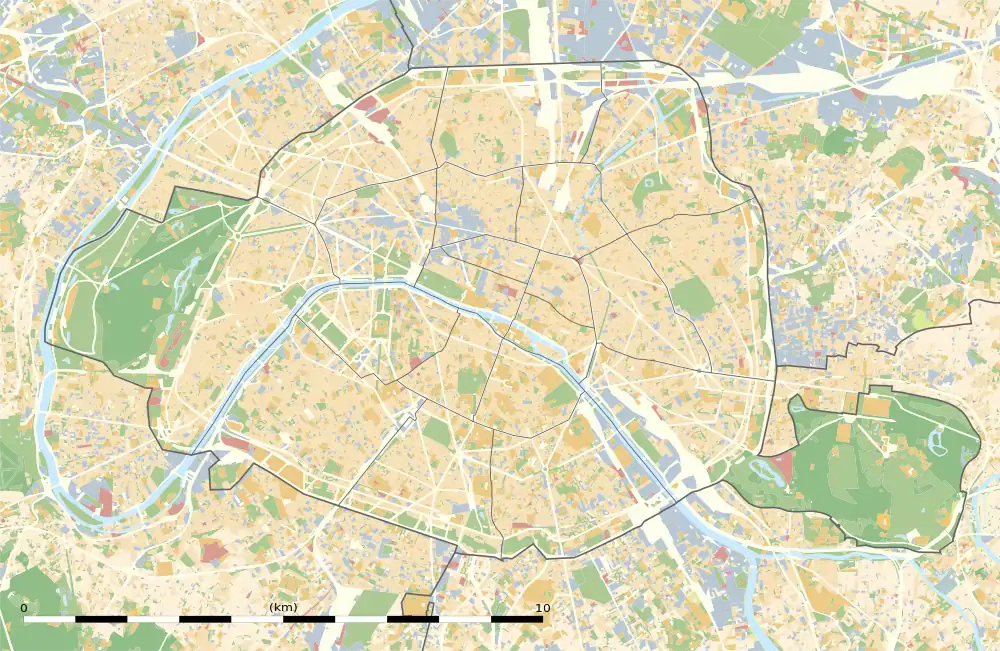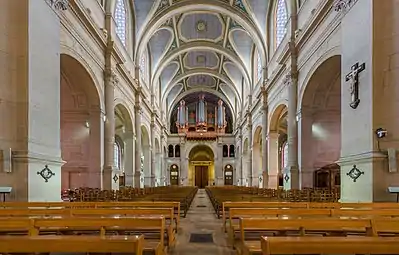Saint-François-Xavier, Paris
St Francis Xavier's Church (French: Église Saint-François-Xavier or French: Église Saint-François-Xavier-des-Missions-étrangères in its long name form) is a Roman Catholic church and parish in the 7th arrondissement of Paris dedicated to Francis Xavier. It gives its name to the nearby Metro station Saint-François-Xavier.
| St Francis Xavier | |
|---|---|
| St Francis Xavier of the Foreign Missions | |
Saint-François-Xavier (in French) | |
 | |
 St Francis Xavier | |
| Location | Paris, Île-de-France |
| Country | France |
| Denomination | Roman Catholic |
| Website | www |
| History | |
| Status | Parish church |
| Dedication | Francis Xavier |
| Consecrated | 23 May 1894 |
| Relics held | Madeleine Sophie Barat |
| Architecture | |
| Functional status | Active |
| Architect(s) | Adrien Lusson Joseph Uchard |
| Groundbreaking | 1861 |
| Completed | 1873 |
| Administration | |
| Deanery | Orsay-Breteuil |
| Archdiocese | Archdiocese of Paris |
| Province | Province of Paris |
| Clergy | |
| Rector | Mgr Bruno Lefèvre-Pontalis |
| Laity | |
| Director of music | Éric Leroy |
| Organist(s) | Denis Comtet Éric Leroy |
History

A séminaire destiné à former des missionnaires à l’apostolat en pays lointains (seminary for foreign missions) had been set up on rue du Bac in 1637 by Monseigneur Duval, with an accord from pope Urban VIII, during the Counter Reformation. The seminary's oratory or chapel was built between 1683 and 1689, with interior decoration by Jacques Stella, Nicolas Poussin and Simon Vouet, and it was this chapel that operated secretly as a parish church for the area during the Revolutionary era when the area's actual parish church of Saint-Sulpice was shut down. In 1801 the chapel was attached to the church of Saint-Thomas-d’Aquin, which became the church for the Faubourg Saint-Germain, and the Missions étrangères parish was officially recognised and split from the parish of Saint-Sulpice in 1802, at which time its curé was abbé Dessaubaz.
40 years later, in 1842, the parish was dedicated to St Francis Xavier. However, the chapel soon became too cramped for the seminarians and parishioners to share and the parishioners began construction on a new church in 1861 under abbé Jean-Louis Roquette (curé of the church from 1848 to 1889), headed by Adrien Lusson then Joseph Uchard and paid for by the Ville de Paris. The chosen site was in the corner of boulevard des Invalides and a planned boulevard right across the district towards rue des Saints-Pères that would meet the Seine level with Pont du Carrousel. According to the principals of Haussmann's renovation of Paris, the new church would then form the end to this planned boulevard, explaining why its siting seems odd today, shifted over the boulevard and the hôtel des Invalides. Lusson began the works, but they were interrupted in 1863 and resumed under Uchard after Lusson's death. Work on the exterior was completed on 15 July 1874 and inaugurated at Easter 1875, at which point the interior decor was still incomplete. It was finally consecrated on 23 May 1894, the eve of Corpus Christi, in a ceremony presided over by François-Marie-Benjamin Richard, archbishop of Paris.
Notable vicars of the new church have included abbé Louis Esquerré (from 1894 - founder of the Patronage du Bon Conseil), Georges Chevrot (1930–58) and Georges Derry (beheaded in Cologne in 1943). The parish now contains 24,000 inhabitants.
Gallery
- Gallery
 Nave looking towards the altar
Nave looking towards the altar Nave looking towards the organ
Nave looking towards the organ